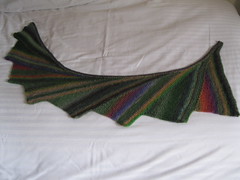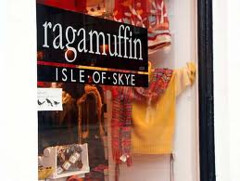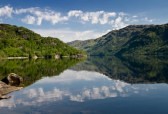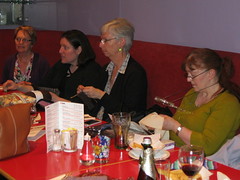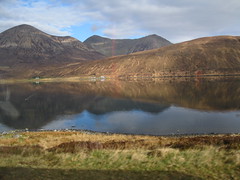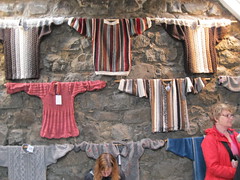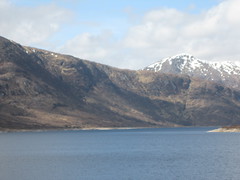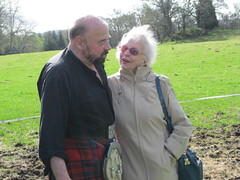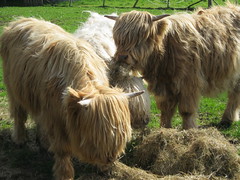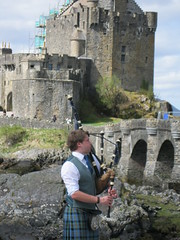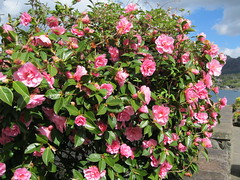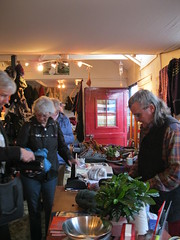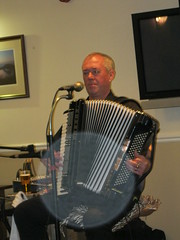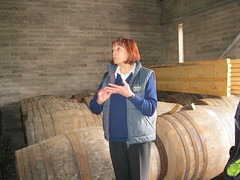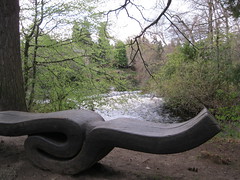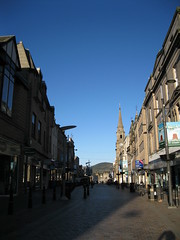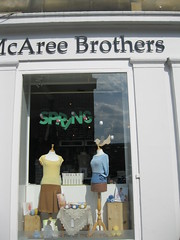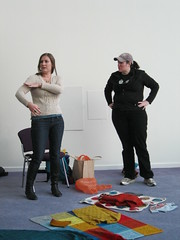As I was packing up for our last bus trip back to Glasgow, I took this picture of my completed
Wingspan Scarf. I just love it, it reminds me so much of the colours of Scotland -- when the sun is out.
During our 45 minute to wait for the ferry to bring us back to the mainland we visited the two VERY clever entrepreneurs who have opened businesses beside the tiny ferry terminal at the end of the road. I went in to
Ragamuffin, and could have spent the day there. Gifts and fashions from all over Scotland, and all over the world. Across the way was
Grumpy George's, where I hear the members of our group who went there also enjoyed themselves very much.
...On the bonny, bonny banks of
Loch Lomond.A full day of countryside through the
Loch Lomond and the Trossachs National Park. This park, which contains Loch Lomond (the largest fresh water loch in the UK) was only established in 2001. As with most national parks there is a tug of war between those who want to make use of the natural riches within the park and those who want to preserve its pristine nature. Such a debate has sprung up in this new park with the result that an Australian company will soon be mining gold within the park under very strict guidelines.
Another interesting piece of
Loch Lomond lore is that sheep were first introduced to the Highlands at Luss on its shores.
Here you go, you
Harry Potter fans. This is the railway trestle in
Glenfinnan which was used in the movies as the Hogwarts Express wound its way through the wilderness to and from school each year.
After checking into our hotel in Glasgow and heading over for the only disappointing meal of the whole trip, some of us walked over to the bar connected to
The Tron Theatre to meet up with some Glaswegian knitters:
Alie is sitting on the far right. Also present were
Catherine who organized the get together, and
Liz (who very patiently repeated her name for me several times as I couldn't make it out with the background noise and her lovely accent.)
Next morning we said goodbye to Iris who was heading on to London before returning to her husband in Hong Kong. The internet is an amazing tool, bringing Iris to join us for the 12 days and drawing other members of our group from
Edmonton, Connecticut and Toronto.
It was a wonderful trip, but as I mentioned to a few people, they should get the
Scottish Tourism Board to look into doing something about that weather! But considering the magnificent day we had to walk around Edinburgh, who can complain.
So here are a few pieces of
Scottish lore that I didn't get to share with you before but I thought were worth mentioning:
-Hills that are over 2 000 feet are referred to as
mountains. Those over 3 000 feet are
monroes.
- Scotland uses the metric system for most things, however distances (such as the feet noted above and distances on highway signs) are still referred to using the old system.
-A wooden stick used to stir porridge is known as a spurtle.
-At the
Tartan Exhibition in Edinburgh, I saw Canada's own
Maple Leaf Tartan whose colours I so adore that I'm making a pair of socks from some yarn just because it had exactly the same colours as my beloved Maple Leaf tartan.
-The specific identification of tartans for individual clans only dates back to the 19th century.
-A kilt is really just a pleated tartan skirt.
Wearing the Plaid however refers to the real deal where men (never women) would suit up by pleating about 1/2 of a very long piece of tartan material on the ground then lying on it to attach it around themselves with a large belt. The remainder would be worn over their shoulder so it could be raised to protect from the rain. At night it could be used as a blanket, and at the end of their days, it was used a shroud.
-The game of
Rugby was originated by a Scottish butcher. No surprising considering the shape of the ball.
-The famed castle of
Eilean Donan cost approximately 250 000 pounds to bring back from its state of ruin in the early 20th century. The shoring up work on a single wall, which is going on today is estimated to cost the same amount.
-Many of us on the tour discovered a wonderful Scottish mystery writer (besides Ian Rankin, of course):
Peter May whose trilogy about
Inspector Fin Macleod, who grew up on the Isle of Lewis but works in Edinburgh, had us rushing to our rooms in spare time to continue the saga.
-You cannot easily find deep fried Mars Bars, despite what you've been told.
-Scotland is a magical place of glorious scenery and generous people.



